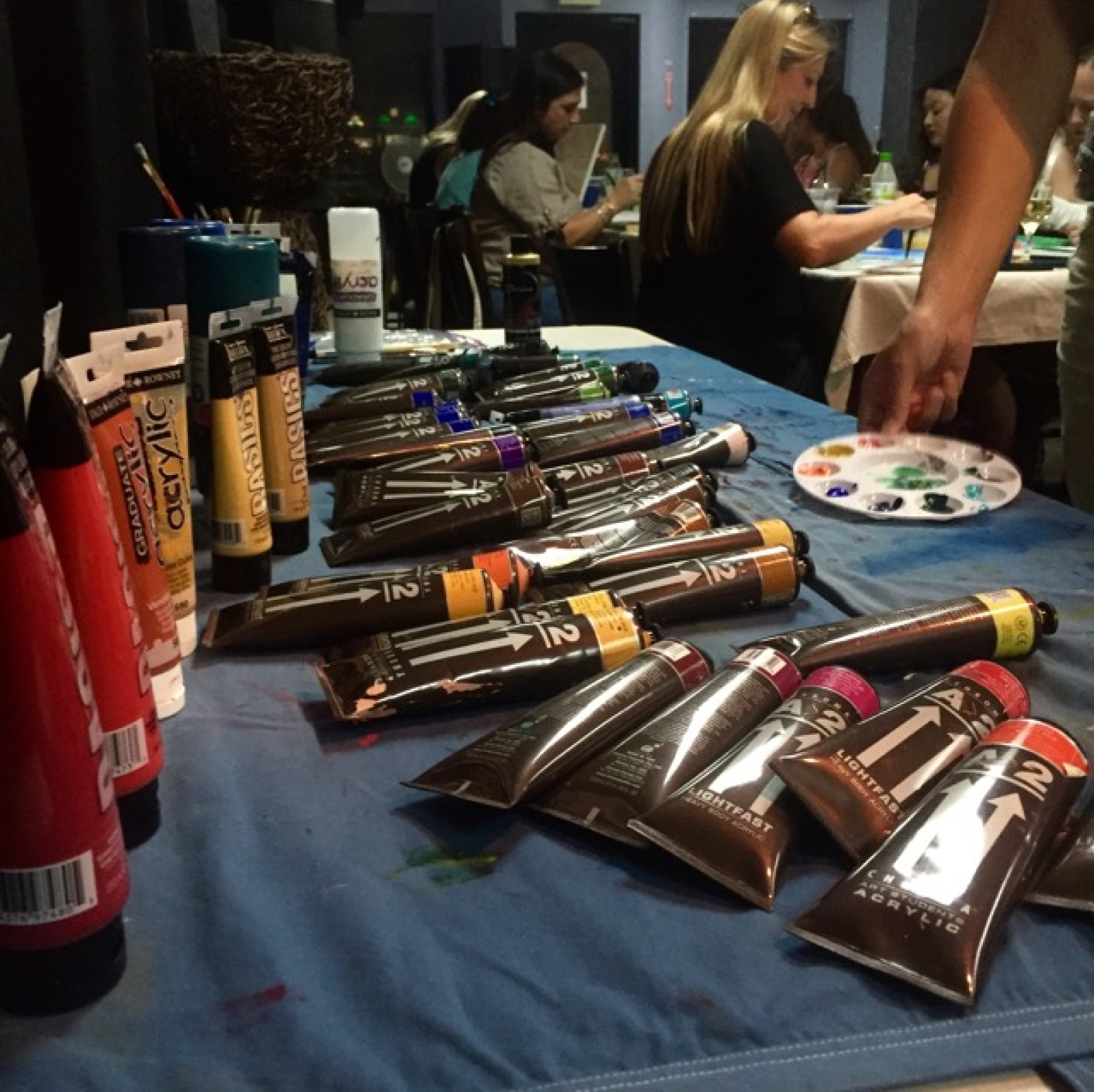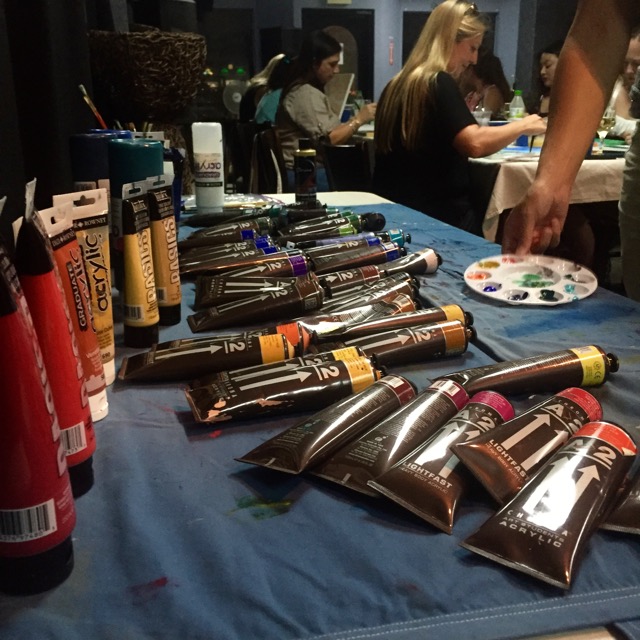One of the most common questions I get asked about painting is: What supplies do you use and where do you buy them?
I am writing this to save myself from repeating my answer over and over. I mean, I don’t mind, but this will be much more helpful, for me and you.
So, painting can be as simple or as technical as you want it to be when it comes to supplies. You can show up to a supply store and grab whatever looks cool and try it out, or you can spend hours carefully researching the best products and techniques. This all depends on your intentions, goals, and personality. I’m the type to just buy what looks generally “good” (looks cool, seems good quality, and is affordable) and then just try it on the canvas.
With that said, I will share here what supplies I use, where I buy them, and how they work for my painting style. This is in no way a thoroughly-researched guide to acrylic painting. This is Shell’s experience, lol.
Acrylic Paints
A quick Wikipedia search describes acrylic paint as follows:
Acrylic paint is a fast-drying paint containing pigment suspension in acrylic polymer emulsion. Acrylic paints are water-soluble, but become water-resistant when dry. Depending on how much the paint is diluted with water or modified with acrylic gels, media, or pastes, the finished acrylic painting can resemble a watercolor or an oil painting, or have its own unique characteristics not attainable with other media.
I love acrylic paints for the characteristics described above… fast-drying, water-soluble out of the tube but water-resistant once dry, totally versatile, vivid and user-friendly. You can thin them down to a watercolor consistency, or use really thick (heavy body) acrylic straight out of the tube for lots of texture. You can read and learn as much as you want about the different types of acrylic paints and mediums with a simple Google or Wikipedia search. There are a million YouTube videos too.
Canvas, brushes, and other supplies:
There are a lot of different surfaces you can paint with acrylics, pretty much anything really. When it comes to canvas, there are pads of canvas sheets that you can pull out as you need. There are rolls of canvas cloth that you can cut and stretch onto a wooden frame. Stretching your own canvas is another step, and you can look up plenty of tutorials on how to do it. Otherwise, you can buy pre-stretched canvas (the route I ended up settling on). Stretched canvas is convenient, and when you finish painting a piece, framing is not necessary (unless you want to). Stretched canvas is ready to hang on a wall.
Brushes can be overwhelming to choose from. There are so many different kinds and brands! To be honest, I just started trying some, and noting which ones I liked and didn’t like. For acrylic painting, it is more typical to use a brush made with synthetic fibers.
There are a million other cool accessories and tools you can utilize in acrylic painting, such as palette knives, scrapers, sponges, etc. Try whatever you want! For this post, I’m keeping it ultra simple.
Essentially: All you really need is paint, canvas, and some brushes. A palette tray to put paint in is helpful, but you can even just use a paper plate or any plastic tray to start with. You can use any cup for water, and something to use as a drop cloth under your painting to protect your floor/table. You don’t even need an easel, I didn’t have one for quite awhile, but eventually bought a table-top easel.
Okay, so on to what I bought and used.
I started with a set of 6 Liquitex Basics acrylics that I had bought at a local office supply store here on Guam, but I quickly realized I wanted more premixed colors. I also found a bunch of liquid acrylics at a local craft store, and bought most of the colors they had, including some metallics. I fell in love with the color variety, and started ordering more paint online. Once I got on a supply website, it was overwhelmingly amazing and dangerous all at once. I bought stretched canvas, a variety of brushes, and unique paint colors I hadn’t tried.
Where to buy:
(On Guam:)
- National Office Supply (they have an array of art supplies, some generic quality for classrooms and some higher quality materials as well)
- Standard Office Supply (Similar to National above)
- Ben Franklin Crafts (they have a selection of arts and crafts supplies)
- K-Mart (For more office/art/craft type stuff, frames, etc… not necessarily canvas and paint)
- Ross (Sometimes they have packs of canvas or other art supplies)
- Shop-4-Less (I’ve seen canvas there)
- Blick Art Materials online (ships to Guam)
If I were starting fresh right now, here is what I would get as a basic starter set for acrylic painting:
Paint: Chroma A2 Acrylics or Liquitex Basics Acrylics: In as many colors as you can afford… they are anywhere from $4-9 for a 4oz or 120mL tube. At the very least, I would get 1 each of: Titanium white, Mars black, Pthalo blue, Ultramarine blue, Pthalo green, Hookers Green, Cadmium red medium/deep, Cadmium yellow medium, Raw umber, Burnt umber, Burnt Sienna, and Dioxazine purple. Other favorites are Unbleached titanium, Red gold, Indian Yellow, Indian Red Oxide, Green light, Cerulean or Cobalt blue. I also love metallic colors, and um, every other color pretty much. I love the Daler-Rowney Graduate acrylics, as they have some cool colors I love, like Indigo, Venetian red, and Turquoise. Buy all the paint! All the colors!
Canvas: Blick Studio Traditional 3/4″ profile cotton canvas (stretched): You can get these in any size you want! Any other brand is fine too, I just find these are affordable and good quality, and what I’ve stuck with. I’ve bought many other brands and kinds with satisfaction though.
Brushes: I like the Royal Langnickel brand, so far I’ve been pleased with their affordable brush sets. There are plenty of great brands out there though. I’d recommend getting an angular set, and a wash/filbert set. I have to say, brushes are one thing I would invest in higher quality (like the Royal Langnickel Majestic brushes). When you feel the way a better brush paints, you too will fall in love.
Extras: A covered palette tray will allow you to save your unused paint on your palette a little longer. It’s totally up to you if you want to try some artist sponges, palette knives, etc.
Easel: You don’t need an easel to get started painting, but it sure helps if you are going to be painting regularly. You can get a table-top easel as an affordable (and compact) way to start. Or you can get a decent quality regular standing easel, like a Richeson Dulce wooden easel.
All together, plan to spend at least $50, and upwards to $200 (or more if you are getting a standing easel).
There you go! The possibilities are endless and this post barely scratches the surface, but hopefully gives you a starting point to simply BEGIN your acrylic painting adventures. Don’t be so careful about it, just get some supplies and experiment!


